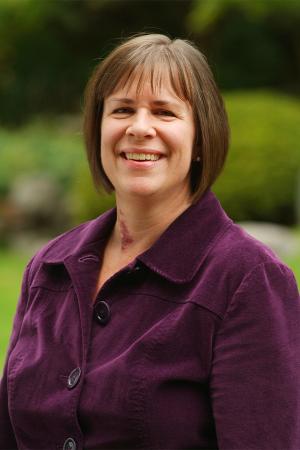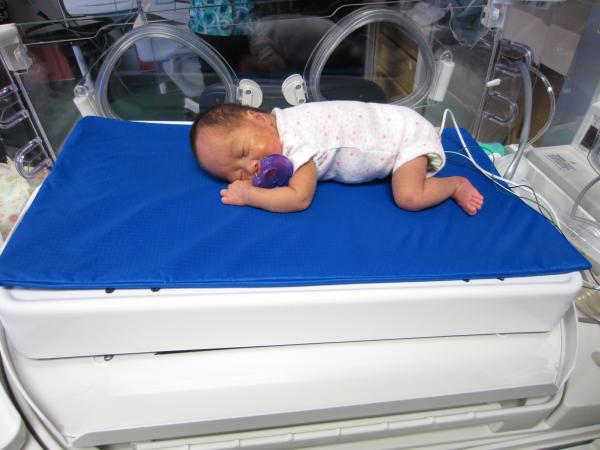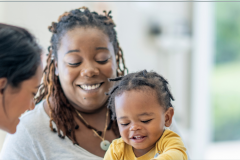The Calmer device is designed to mimic skin-to-skin contact and comfort preterm babies receiving medical treatment in hospital.
BCCHR's Ask an Expert Series

We asked an expert about the Calmer device that's being trialled at BC Women's Hospital + Health Centre in Vancouver, B.C.
Approximately 4,500 infants are born premature in British Columbia each year. These preterm babies, born before 37 weeks gestation, still have developing nervous systems and are not yet ready for the onslaught of sensory information they experience in the hospital.
In addition to the lights and sounds of the hospital, preterm babies may be exposed to up to 15 painful procedures each day, such as blood tests, insertion and removal of catheters, and so on — all of which are required for care. These procedures can lead to ongoing stress responses that can negatively impact neurodevelopment.
Evidence has linked early and frequent exposure to painful stimuli with altered brain growth and negative cognitive, motor and emotional development. Other adverse effects include behavioural problems, learning disorders, vision problems, and depression.
To help create a non-medicinal way to reduce pain and stress in preterm newborns, researchers at BC Children's Hospital, the University of British Columbia, the British Columbia Institute of Technology, and BC Women's Hospital + Health Centre designed a therapeutic medical device that simulates some aspects of human skin-to-skin contact in the neonatal intensive care unit (NICU).

Calmer, as this device is called, mimics parent's heartbeats, up and down breathing motions and the feel of human skin.
Two studies published in PAIN Reports (2019, 2021) found that Calmer was no different than skin-to-skin contact at reducing pain-related indicators in premature infants. While Calmer is not to be used to replace skin-to-skin contact, the findings suggest that Calmer provides pain relief and comfort when there are reasons that the baby cannot be held.
Earlier this year, a new version of Calmer was released. The new version is more durable, keeps track of cycles, and has an aesthetically pleasing, user-friendly digital controller.
We spoke with Dr. Liisa Holsti, lead Calmer inventor and occupational therapist, about the unique benefits of Calmer and the future of this helpful device.
Have you had any surprising results from Calmer-related research?
The most surprising and wonderful results came when we interviewed a group of mothers. The mothers described Calmer as "an extension of themselves." While Calmer is not a replacement for human touch, knowing that Calmer was available when they couldn't be with their infant reduced these parents' stress.
What would you like to see happen with Calmer?
I would like to see Calmer functionality embedded into incubators around the world. I would also like to have single, free-standing units available for any infants worldwide who might need them. To that end, in addition to our work in Vancouver, we are currently redesigning Calmer for implementation in low-resource settings.
What are the next steps for Calmer?
We'll next study the effects of Calmer when used for longer periods of time — over weeks. We want to know how Calmer impacts the infants' growth and development, their families and the NICU staff during their workflow. With grant funding from UBC Health, we are starting a new pilot study in the BC Women's Hospital NICU this month (July 2021) to test this question with the four new prototypes we built with BCIT using the generous funds donated to BC Women's Health Foundation.
What would you most like people to know about Calmer?
I am working every day with an outstanding team of trainees, researchers, clinicians, human computer interaction designers, engineers and technology transfer specialists to improve the outcomes of vulnerable infants who require advanced hospital care. I hope Calmer can play a part in ensuring optimal neurodevelopmental outcomes for these infants and their families.
And I'd like to thank the many individuals, granting agencies, and especially those in the Department of Occupational Science and Occupational Therapy at UBC, BC Women's Hospital + Health Center, BC Women's Health Foundation, British Columbia Institute of Technology, BCCHR and the PHSA Technology Development Office who took a chance on me in developing Calmer, and who have helped us fund, build and test Calmer over these past 11 years.

In this two-minute video, Dr. Liisa Holsti talks about the Calmer device and a mother talks about the benefits of Calmer:




